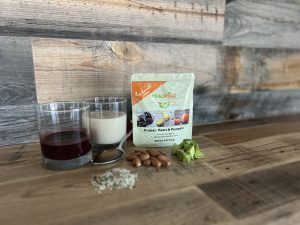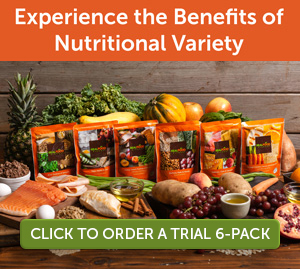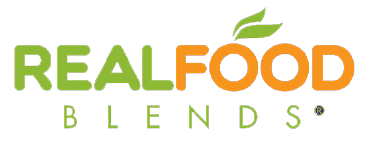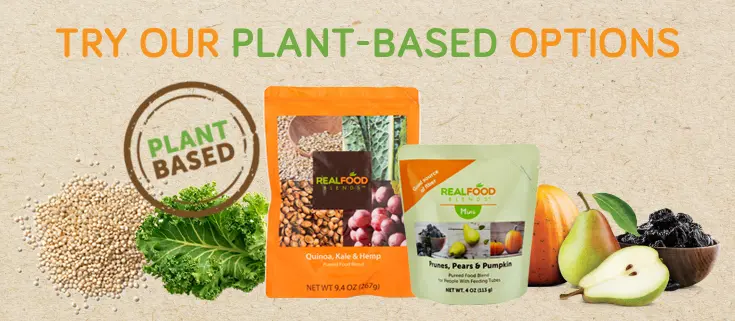
Navigating Plant-Based Blended Tube Feeding: What to Look For and What to Include by Hilarie Dreyer RD, CSP
With plant-based commercial products like Real Food Blends Quinoa Kale and Hemp pouch and Real Food Blends Mini, and the ability to blend food at home for tube feeding it is now simpler for those requiring tube feeding to meet their dietary preferences and nutrition goals with a plant-based approach.
As a Registered Dietitian and passionate advocate of blended tube feeding, it’s important to me to give those fed via feeding tube choice back in how they nourish themselves, while also respecting their beliefs and preferences.
Therefore, this article is not meant to advocate for any one specific diet. Rather, its purpose is to provide necessary information to make informed choices when following a plant-based blended tube feeding diet.
A Plant-Based Approach for Blenderized Diets: What Does It Look Like?
People who follow a plant-based diet tend to prioritize eating foods like fruits, vegetables, whole grains, beans, legumes, nuts, and seeds, and may limit or omit certain animal products such as meat, fish, eggs, and dairy.
There are many variations of this diet and it can look different from person to person. Some may opt for a strictly vegan diet, while others may opt to incorporate plant-based meals only on certain days of the week.
And guess what, it is the same for tube feeding! After all, for most people a feeding tube is just another way to get nutrients into the body.
Whether you eat by mouth or through a feeding tube, there are a few things to consider when following a plant-based diet. This article will review what nutrients might be missing, and how to incorporate them into your blended meals so you can maintain optimal health.
And because I’m all about making the blending process as simple as possible, I’ll be offering tips and tricks along the way, such as using ready-made products like Real Food Blends to save time on meal preparation. And don’t miss the sample one-day blended diet meal plan at the end!
Important Nutrients on a Plant-Based Blended Diet
Protein:
Protein is super important for keeping our bodies running smoothly, as well as building and maintaining muscle and bones. Animal-based proteins are especially great as they give us all the essential amino acids (building blocks of protein) that our bodies need.
Plant-based proteins don’t usually provide all the essential amino acids in the right amounts, but if you mix and match different plant-based foods, you can get the amino acids your body needs.
Here are some of my favorite plant-based protein sources for a blended diet:
- Tempeh
- Edamame
- Tofu
- Lentils
- Nuts and Seeds
Blended Tube Feeding Tips: Lentils thicken up blended meals quickly. I suggest starting with a small amount to avoid an overly thick meal.
Iron
Iron is important for our bodies and plays a role in oxygen transport. It does this through a special protein called hemoglobin found in our red blood cells. This oxygen delivery is important for our energy levels, keeping our cells healthy, and supporting our immune system.
If you’re looking to get enough iron on a plant-based diet, it can be a little tricky. This is because the kind of iron found in plant foods is not as easily absorbed as other types. To ensure your body is taking in the most iron possible, combine iron-rich foods with those high in vitamin C, such as oranges and strawberries.
Here are some of my favorite plant-based iron sources for a blended diet:
- Spinach and Swiss Chard
- Kidney Beans and Lentils
- Fortified Cereals
- Blackstrap molasses
- Tofu
Blended Tube Feeding Tips: Real Food Blends Quinoa Kale and Hemp packet contains 7 mg of iron in one packet! Blending in a citrus fruit or juice will help your body absorb the iron and get the most out of your meal.
Vitamin B12
Vitamin B12 is important to keep your brain, heart, muscles, and nerves healthy. Unfortunately, our bodies do not make B12 on their own so we need to get it from food or supplements. Those following a plant-based diet must pay special attention to vitamin B12, as it is only found naturally in animal foods.
Here are some of my favorite plant-based vitamin B12 sources for a blended diet:
- Fortified Nutritional Yeast
- Fortified Plant-Based Beverages (coconut, almond, oat, pea, rice and soy milks)
- Fortified Plant-Based Meat Alternatives
- Fortified Cereals
Blended Tube Feeding Tips: Adding fortified nutritional yeast to blended meals is an excellent way to add calories and get a good dose of vitamin B12. There are many shelf-stable options available, making it a pantry staple for those on a plant-based blended diet.
Vitamin D
Vitamin D is essential for healthy bones, a functioning immune system, and keeping nerves and muscles in good shape. Unfortunately, getting enough of it can be tricky. Fish and seafood are great sources of vitamin D, but otherwise it is not present in many foods, and it’s hard to get enough year-round sunshine (trust me, I live in Michigan and know the feeling!)
Here are some of my favorite plant-based vitamin D sources for a blended diet:
- Fortified Breads and Cereals
- Fortified Orange Juice
- Fortified Plant-Based Beverages
- Mushrooms (Exposed to UV Light – Labeled as Such on the Package)
Blended Tube Feeding Tip: Families I work with often opt for fortified plant-based beverages as the liquid base in blended meals to increase calories. In order to create high calorie, low volume meals, look for a plant-based beverage with at least 130 calories per 8 ounce serving.
Calcium
If you want to help keep your bones strong and support nerve and muscle health, it’s important to make sure that calcium is a part of your diet. Animal-based foods, like milk and yogurt, contain a lot of calcium and are easier for the body to absorb than plant-based calcium sources.
If you’re following a plant-based diet, don’t stress – there are many foods that are packed with calcium that are perfect for tube feeding. Try adding several of these nutrient-rich foods to your blended meals throughout the day to ensure you’re getting the calcium you need.
Here are some of my favorite plant-based calcium sources for a blended diet:
- Tofu in Calcium Sulfate Brine
- White Beans and Navy Beans
- Seaweed and Kelp
- Fortified Cereals and Oats
Blended Tube Feeding Tip: Tofu is a great addition to blended meals! It blends easily and is nutrient dense. Look for tofu in calcium sulphate, a commonly used coagulant in making tofu.
Zinc
Zinc is an important micronutrient that helps keep your immune system in tip-top shape! It also is vital for the proper functioning of the human body, in general.
Zinc can be acquired from both plant and animal-based foods, however it is less easily absorbed in plant-based sources than animal based-sources.
Here are some of my favorite plant-based zinc sources for a blended diet:
- Wheat Germ
- Hemp Hearts
- Fortified Cereals
- Pumpkin Seeds
Blended Tube Feeding Tip: If you’re looking for a calorie-rich way to amp up your blended meals, look no further than hemp hearts! Just 3 tablespoons can give you approximately 180 calories, depending on the brand, and you can usually find them in the baking aisle of your local grocery store!
Omega-3 Fatty Acids
Omega-3 fatty acids are essential for keeping your heart healthy. It can be difficult to get enough omega-3 on a plant-based diet as the main sources are found in animal products such as fish and eggs. You can get some of your omega-3 from plant sources like walnuts, chia seeds and flaxseeds. It is important to talk to your health care team about omega-3 supplements if you follow a strictly plant-based diet.
Your Recommended Nutrient Needs
Figuring out your nutritional needs can be daunting. Everyone’s needs vary, and it can be hard to track down reliable info. If you want to get a head start, the Dietary Guidelines for Americans is a great resource. When you’re ready, however, it’s best to consult with a dietitian or health care team to get your exact requirements.
Sample One-Day Plant-Based Meal Plan
If you’re looking for inspiration for your tube feeding regimen here is a sample plant-based meal incorporating Real Food Blends. The recipes are easy to follow and packed with nutrients!
Real Food Blends provides an easy way to incorporate real food into your tube feeding routine, without having to make every meal from scratch!
- Breakfast: ½ Acai Smoothie Bowl with Real Food Blends Mini recipe (250 mL)
- Lunch: 1 pouch Real Food Blends Quinoa, Kale & Hemp (240 mL)
- Snack: 1 pouch Real Food Blends Mini Prunes, Pears & Pumpkin (100 mL)
- Dinner: ½ Edamame Salad with Tahini and Real Food Blends Quinoa recipe (225 mL)
Provides: Approximately 1160 calories, 37 grams protein
Please note, this is simply a one-day meal plan and is not meant to be primary source of nutrition. Consult with your medical team before making any changes to your diet. If micronutrients are a concern, a 100% complete multivitamin can be a simple solution, and if needed an additional calcium supplement and sodium per clinician recommendation.
Recipes:
- 1 pouch Real Food Blends Mini Prunes, Pears & Pumpkin
- 1 acai smoothie packet (3.5 oz)
- 1 slice avocado (~1/8 avocado)
- 1 Tbsp hemp hearts
- 1/4 cup almonds
- 2 Tbsp honey
- 1 cup extra creamy oat milk
Add food and liquid to the blender and blend on high for ~2 minutes, or until completely liquified and with no chunks. You may need to strain the blended meal if there are any pieces/chunks.
This yields ~500 mL, with approximately 740 calories (1.5 calories per mL) and 15 g of protein for full recipe. This will make enough for 2 servings. Store unused portion in refrigerator for up to 24 hours. However, the exact nutritional content may vary by brand or type.
Edamame Quinoa Salad with Tahini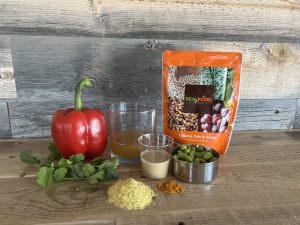
- 1 pouch Real Food Blends Quinoa, Kale & Hemp
- 1/4 cup edamame
- 1/4 cup red pepper, raw
- 1/4 cup cilantro, raw
- 3 Tbsp tahini*
- 2 Tbsp nutritional yeast
- 1/2 tbsp turmeric, ground
- 1/4 cup vegetable broth
Add food and liquid to the blender and blend on high for ~2 minutes, or until completely liquified and with no chunks. You may need to strain the blended meal if there are any pieces/chunks.
This yields ~450 mL, with approximately 725 calories (1.6 calories per mL) and 33 g of protein for full recipe. This will make enough for 2 servings. Store unused portion in refrigerator for up to 24 hours. However, the exact nutritional content may vary by brand or type.
*Contains sesame.
I hope this article has been helpful to you, and that you will enjoy making these nutritious blended meals for either yourself or your tube fed loved one!
Happy Blending,
Hilarie, RD, CSP
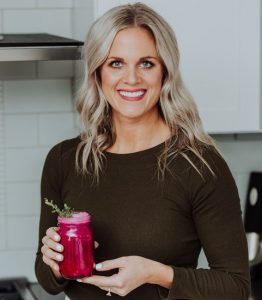 Hilarie Dreyer, RD, CSP is a registered dietitian with over 7 years of tube feeding experience. She is the founder of Blended Tube Feeding, a virtual private practice that supports families with blenderized diets. Her mission is to advocate for better acceptance of blenderized diets in the medical community and to support families with their blending journey along the way.
Hilarie Dreyer, RD, CSP is a registered dietitian with over 7 years of tube feeding experience. She is the founder of Blended Tube Feeding, a virtual private practice that supports families with blenderized diets. Her mission is to advocate for better acceptance of blenderized diets in the medical community and to support families with their blending journey along the way.



